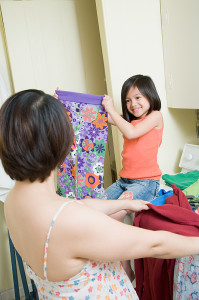Help Kids Become Clutter Busters by Rita Emmett
 Note from Meggin: There are times you probably feel like your students’ parents – but of course, you are not. Their real parents might appreciate this list of tips, which are shared by guest author, Rita Emmett. Think about passing them along:
Note from Meggin: There are times you probably feel like your students’ parents – but of course, you are not. Their real parents might appreciate this list of tips, which are shared by guest author, Rita Emmett. Think about passing them along:
- Make it easy to keep clothes neat. Put shoe boxes without lids in drawers to help keep clothes from getting jumbled. Maybe socks in one shoe box, underwear in another. You can use any kind of container, but if you are a true Clutter Glutton, you still have every shoe box that has ever entered your home, so you may as well use them.
- Help them get drawers and the closet to a state where they can easily fit their clothes and other belongings into them without pushing or shoving.
- To simplify the children’s laundry, try assigning a separate “signature” color to each child for towels, sheets and blankets.
- Put clothes hampers (or baskets or boxes) in each child’s room. Any dirty clothes not in the hamper don’t get washed.
- Roommates handle their shared space better if a parent or someone helps to establish clear boundaries. This is Meghan’s drawer and this is Cassidy’s drawer; or this is Connor’s shelf, this is Noah’s shelf. And so on. Sometimes labels are needed to help keep things straight.
- Some children have an extra twin bed in their room “for sleepovers.” But most friends know to bring a sleeping bag and pillow when they sleep over. Space is too valuable to waste on a spare bed that just collects clutter on it. Unless the extra bed is used frequently, sell it or give it away to someone who will use it, and free up some space in your child’s room. Two options that do not use up floor space are:
- a trundle bed where the mattress stores under the bed.
- a bunk bed, but the extra bed could still become a magnet for clutter.
- Help your children (teens need help too) to de-clutter but let them make choices. Then teach them to cultivate simple habits to help them maintain a clutter free environment.
- When helping them de-clutter, give children the opportunity to decide what stays and what goes. If they can get rid of only a few things at first, let it be. Let them see how you’re getting rid of your stuff.
- If the family is working together to de-clutter one area, have a big celebration when it’s clear or a mini-celebration after one solid hour of work.
- Set up a box or plastic bag in a permanent spot in the house, such as a closet or the garage. Encourage your children to contribute items to the donation container that you’ve set up for the family. When the bags are full, donate them to your favorite charity.
© Rita Emmett, author of The Procrastinator’s Handbook; The Procrastinating Child: A Handbook for Adults to Help Children Stop Putting Things Off and The Clutter-Busting Handbook, is a “Recovering Procrastinator” and professional speaker. She can be reached at 847-699-9950 and email is Rita@RitaEmmett.com.
To subscribe to her free monthly “Anticrastination Tip Sheet” with quick short tips & ideas to help break the procrastination habit, go to the first page of her website www.RitaEmmett.com
 And if you’d like more ideas to help you find balance in your space you will want to access the Get a Plan! Guide® to De-clutter & De-stress: A Dozen Ways to Decrease Your Clutter and Decrease Your Stress. This Get a Plan! Guide® will help you learn a dozen specific ways to start dealing deliberately with your clutter – and then experiencing a reduction in your stress.
And if you’d like more ideas to help you find balance in your space you will want to access the Get a Plan! Guide® to De-clutter & De-stress: A Dozen Ways to Decrease Your Clutter and Decrease Your Stress. This Get a Plan! Guide® will help you learn a dozen specific ways to start dealing deliberately with your clutter – and then experiencing a reduction in your stress.


